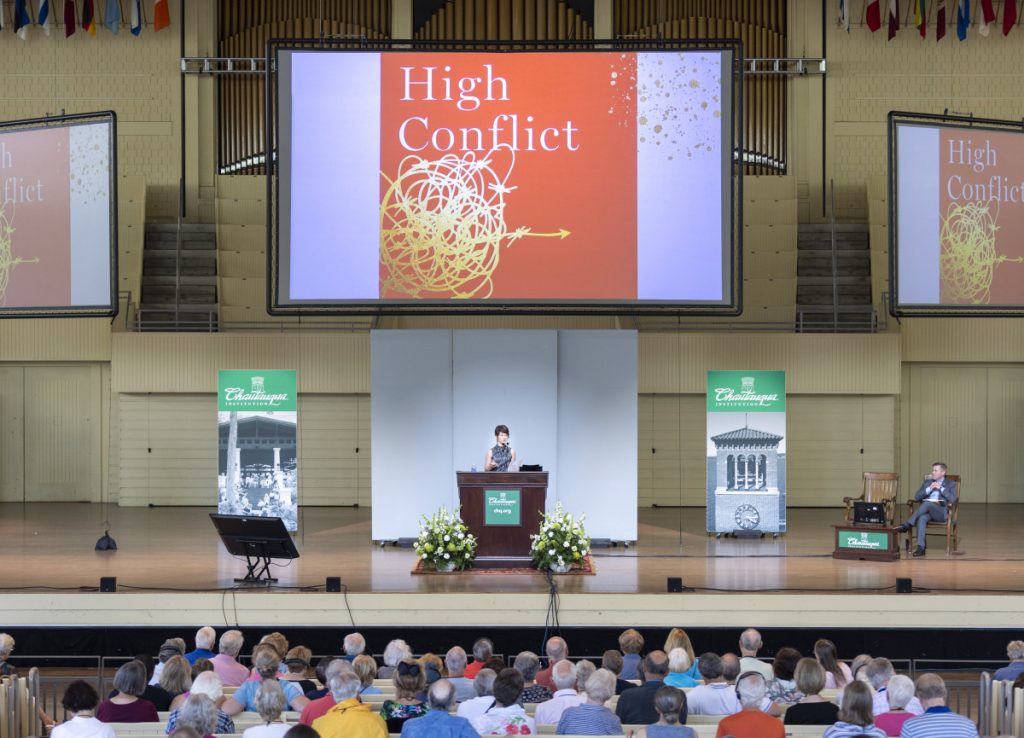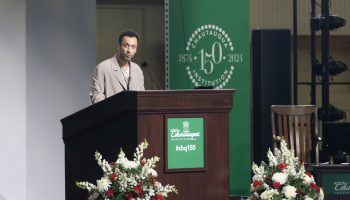NICK DANLAG – STAFF WRITER

John Adams and Thomas Jefferson were close friends before they were political adversaries. Adams took a young Jefferson under his wing, and the two collaborated to write the Declaration of Independence. But even the strongest connections, whether between family or friends, wither under the pressure of high conflict.
Amanda Ripley, a New York Times-bestselling author, defined high conflict as a period of argument or disagreement in which the conflict itself becomes the focus, instead of the logical facts or even feelings.
High conflict has three key features: group identities, humiliation and outside conflict entrepreneurs. Both Adams and Jefferson initially opposed the idea of political parties, then were swept into different factions, until they stood as competing candidates for president.
Running against his protégé in the 1796 presidential election and almost losing was a public humiliation for Adams. Ripley, quoting Nelson Mandela, said, “You mustn’t compromise your principles, but you mustn’t humiliate the opposition. No one is more dangerous than the one who is humiliated.”
The last nail in this conflict coffin came from Jefferson’s camp, specifically from another future president, James Madison. When Jefferson drafted a letter apologizing to Adams, Madison recommended he not send it because it could damage Jefferson’s reputation if it got leaked.
“For the sake of the young country, there was a lot they should have discussed,” Ripley said. “But that’s not what happened, because this was high conflict, in which everyone suffers to various degrees.”
And, well over 200 years since Adams and Jefferson, much of society lingers in this trap of high conflict: 80% of Americans are stressed about the future, half have stopped talking to someone about politics because of the person’s beliefs and two-thirds hold a political view they are afraid to share.
As well as her book, High Conflict: Why We Get Trapped and How We Get Out, Ripley’s work has appeared in The Atlantic, The Washington Post, The Wall Street Journal and many others. At 10:30 a.m. on Monday, July 19 in the Amphitheater, Ripley discussed the nature of good and high tension, the hard trek of bridging divides and multiple real-life examples of people in different fields, from politics to organized crime, working toward a better-connected society.
Her lecture, “The Conflict Trap,” opened Week Four’s theme of “Many Americas: Navigating Our Divides” of the Chautauqua Lecture Series.
Around five years ago, Ripley realized facts weren’t enough and traditional journalism wasn’t equipped to bridge the growing fragments of the U.S.
“I wish I recognized this earlier: Our perception matters more than the facts all the time,” Ripley said. “I hate that it’s true, but it’s especially true in conflict.”
So she sought out people who had a lot of experience in high conflict situations, from health care workers to politicians to soldiers. Through these conversations, Ripley saw how conflict can transition from good to high.
Good conflict, as Ripley defined, is dynamic, when both sides discuss, listen and act. Even if the arguments are tense and emotions are high, good conflict leads somewhere.
“People do escape high conflict. They don’t suddenly agree, and this is important: They don’t surrender their beliefs. They don’t censor them, either,” Ripley said. “Instead, they do something much more interesting. We become capable of comprehending that with which they disagree. And that changes everything: Curiosity returns, IQs go back up, conflict becomes necessary and good instead of destructive.”

Ripley noticed a pattern in her conversations. In times of high conflict, people were able to break out when they are able, or are forced, to pause. Usually, this is the point where people realize they are losing more than they are gaining.
This point could occur when a child becomes sick when parents are fighting, or a catastrophe during wartime. For 10 years during the Colombian Civil War, Ripley said 52,000 people left the armed conflict voluntarily.
“People left the conflict when they reached a saturation point. Sometimes it was when their side experienced major casualties. Sometimes it was when their unit ran low on money,” Ripley said. “Misery can create opportunity.”
Ripley said during soccer games, the Colombian government ran ads inviting rebel fighters to come home and watch games with their families. The day after each soccer game, there were 20 extra demobilizations — 10 times the daily average.
“But, really, the best defense against high conflict that I’ve seen is to create a counterculture of good conflict. That sounds so starry-eyed, I know, like a fantasy,” Ripley said. “So to prove that it’s possible, I want to tell you one last story today.”
B’nai Jeshurun, an influential Manhattan synagogue, had major tension among its congregants after the rabbis praised a United Nations vote favorable to Palestinians. Some members adamantly supported Israel, while others held harsh critiques. The conflict landed on the front page of the The New York Times, members withheld their donation and left, and others remained silent.
“The rabbis were stunned. It felt like an earthquake,” Ripley said. “People they loved and respected and thought loved and respected them were saying terrible things very publicly.”
So the leaders of the synagogue decided to bring in outside experts on conducting conversations.
“So it wasn’t ‘Kumbaya;’ it was more like training for an Ironman competition, just to be clear. It was hard. There were structured workshops and intensive staff training, in-depth sessions with the rabbis and the board,” Ripley said. “The goal was to understand, not to agree: a huge, but underappreciated, difference.”
Ripley said that being heard often makes a person more willing to listen to others. People shared personal stories about their “connections to Israel, about feeling torn between their sense of justice and their sense of duty.”
“One woman explained how so many of her relatives had been killed in the Holocaust. She’d been raised to believe that any criticism of Israel was sacrilegious,” Ripley said. “This didn’t make other people agree with her suddenly, but it’s helped them to be less mystified by her.”
After months and months of listening sessions, the synagogue discovered the underlying conflict: fear for the future and a fear of speaking out. Ripley said most had ambivalent feelings toward Israel, with some changing their opinion day by day depending on how questions were asked.
The discussions, for three years, barely resembled those of a high conflict. The synagogue continued to use these methods through many different conflicts and discussions. Then something different came along: Donald Trump’s election in 2016.
“This didn’t seem to be a conflict they could lean into. It felt unique,” Ripley said. “How could they cultivate good conflict with people they’ve never met?”
Most of the synagogue’s congregants voted for Hillary Clinton, so they couldn’t resolve this conflict without reaching outside their organization. Very far, in this case — all the way to Michigan, where 16 conservative Christians who worked in a prison were willing to join in deep conversations.
The program worked like this: First the members of the New York synagogue would live with the Michiganders for three days, then a few months later, the reverse would happen. Ripley talked to and interviewed both sides, and saw similar fears.

The New Yorkers expected bigotry; one was fearful they would be shot. The Michiganders, on the other hand, expected condescension; one was fearful they were inviting Antifa into their homes.
“It occurred to me that it might have been less nerve-racking for these Americans to host actual foreigners rather than fellow Americans,” Ripley said. “But, for reasons none of them could fully articulate, about a dozen New York liberals and a dozen Michigan conservatives signed on, and they all agreed to let me come along.”
Despite their political, geographic and religious differences, the two groups grew to understand each other. Some of the New Yorkers even took their companions to Trump Tower to buy memorabilia.
“It was a strange encounter to behold, slightly contrived but less awkward than it sounds. I had left Washington D.C., where the politicians remain locked in combat, to watch these Americans doing something much more interesting: Coming together with copious misunderstandings and many questions. Despite everything, they still wanted to make sense of each other.”
As part of the Q-and-A session, Chautauqua Institution President Michael E. Hill asked Ripley what the first step is to escaping high conflict.
Ripley said a good first step is to create a non-aggression pact. While this is a step short of a full peace treaty or resolution, rules of engagement often stop tensions from starting. One example is an agreement between gangs in Chicago to not taunt each other on social media, and for gang members not to go to areas they did not control. Ripley said this was a very important first step because 70% of gang conflict in Chicago starts on social media.
“So, basic parameters … create that cause of the conflict,” Ripley said. “Then here’s the interesting thing: Someone always violates the pact. Always. But you have a process in place to slow down the escalation.”
This was the case in Chicago. One gang member posted a photo on Facebook of him with a gun on a street corner, “mocking the organization who had this territory,” and mediators were able to contact the other gang and ask for a two-hour window before retaliating. Within an hour and a half, the photo was taken down, and the situation ended without any shots fired.
“So, this is an example of how you can slow down those forces of humiliation especially,” Ripley said.
“Why would we ask traumatized young men in violent situations to do something we have not asked the members of Congress to do?”
Hill then asked Ripley if COVID-19 and the Jan. 6 insurrection could not interrupt the high conflict in the U.S., what can?
“I do think that some people did escape high conflict in the aftermath of both of those shocks,” Ripley said. “… (There were) families that were estranged, and then the pandemic happened and they’re not anymore.”
When she wrote about polarization for The Atlantic, researchers would half-jokingly tell her that if an alien invasion happened, society would have a common enemy and unify to solve a lot of its problems.
“Then we got it. But we have conflict entrepreneurs in charge,” Ripley said. “So that was a missed opportunity, not in every place, but in a lot of places. Unfortunately, there will be more opportunities, I promise you.”




